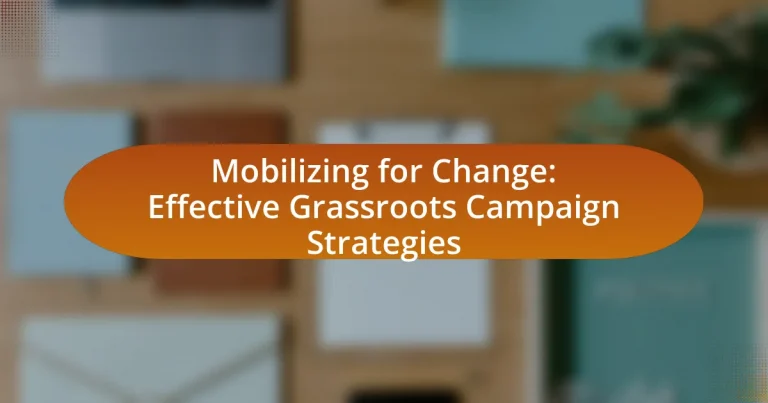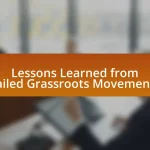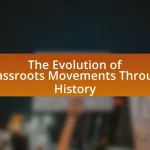Grassroots campaign strategies are essential methods for mobilizing community members to engage in advocacy and political action, focusing on local support through direct engagement techniques such as canvassing and social media outreach. This article explores the differences between grassroots and traditional campaigns, highlighting key characteristics, foundational elements, and the importance of community engagement in driving social change. It also addresses challenges faced by grassroots campaigns, innovative approaches, and effective strategies for mobilization, messaging, and volunteer recruitment. Successful examples of grassroots movements, such as the Civil Rights Movement and the Women’s March, illustrate the impact of collective action in achieving significant policy changes.
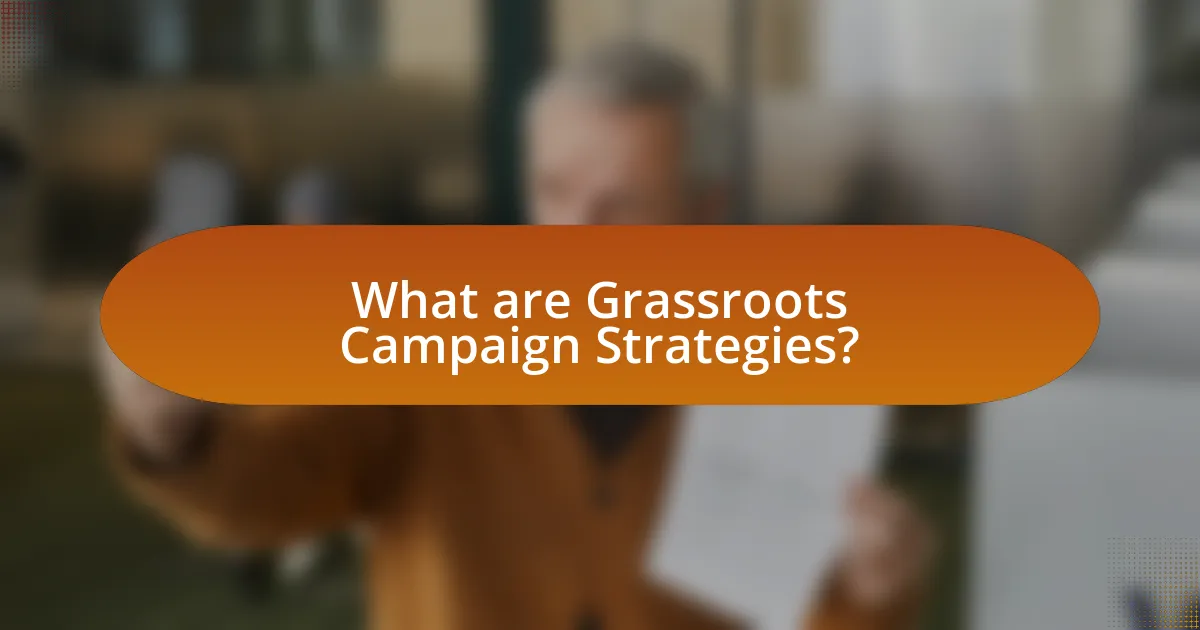
What are Grassroots Campaign Strategies?
Grassroots campaign strategies are methods employed to mobilize community members and engage them in advocacy or political action. These strategies often focus on building local support through direct engagement, such as door-to-door canvassing, community meetings, and social media outreach, to influence decision-makers or raise awareness about specific issues. Research indicates that grassroots movements can significantly impact policy changes; for example, the 2018 March for Our Lives campaign effectively mobilized youth and community members to advocate for gun control legislation, demonstrating the power of collective action in grassroots efforts.
How do grassroots campaigns differ from traditional campaigns?
Grassroots campaigns differ from traditional campaigns primarily in their approach to mobilization and funding. Grassroots campaigns rely on community involvement and small donations from individuals, emphasizing local engagement and volunteer efforts, while traditional campaigns often depend on large donations from wealthy donors and political action committees, focusing on media advertising and established political networks. For example, the 2008 Obama campaign utilized grassroots strategies effectively, raising over $500 million from small donors, contrasting with traditional campaigns that typically prioritize big fundraising events and corporate sponsorships. This fundamental difference shapes the strategies, outreach, and overall impact of each campaign type.
What are the key characteristics of grassroots campaigns?
Grassroots campaigns are characterized by community-driven efforts that mobilize individuals at the local level to advocate for social or political change. These campaigns typically emphasize collective action, where ordinary citizens engage in organizing, fundraising, and outreach to influence decision-makers. A defining feature is their reliance on volunteer participation, which fosters a sense of ownership and empowerment among community members. Additionally, grassroots campaigns often utilize social media and digital tools to amplify their message and reach a broader audience, as seen in movements like the Women’s March and Black Lives Matter, which effectively mobilized large numbers of participants through online platforms.
Why are grassroots campaigns important for social change?
Grassroots campaigns are important for social change because they empower individuals and communities to advocate for their needs and influence policy decisions. These campaigns often mobilize local support, fostering a sense of ownership and engagement among participants, which can lead to sustained activism. For instance, the Civil Rights Movement in the United States relied heavily on grassroots organizing, enabling marginalized voices to challenge systemic injustices and ultimately achieve significant legislative changes, such as the Civil Rights Act of 1964. This historical example illustrates how grassroots efforts can effectively drive social transformation by creating a collective force that demands accountability and change from those in power.
What are the foundational elements of effective grassroots campaigns?
The foundational elements of effective grassroots campaigns include community engagement, clear messaging, and strategic organization. Community engagement fosters relationships and builds trust among constituents, which is essential for mobilizing support. Clear messaging ensures that the campaign’s goals and values resonate with the target audience, making it easier to rally people around a common cause. Strategic organization involves planning and coordinating activities, such as events and outreach efforts, to maximize impact and reach. These elements are supported by successful case studies, such as the 2008 Obama campaign, which effectively utilized grassroots strategies to mobilize millions of voters through community organizing and targeted messaging.
How do community engagement and mobilization play a role?
Community engagement and mobilization are crucial for grassroots campaigns as they foster collective action and empower individuals to influence change. Engaging community members creates a sense of ownership and responsibility, which enhances participation in initiatives aimed at addressing local issues. For instance, research by the National Civic League indicates that communities with high levels of engagement experience improved social cohesion and better outcomes in public health and education. Mobilization transforms this engagement into action, enabling communities to advocate for their needs effectively, as seen in successful movements like the Civil Rights Movement, where organized community efforts led to significant legislative changes.
What strategies can be employed to build a strong volunteer base?
To build a strong volunteer base, organizations should implement targeted recruitment, effective training, and ongoing engagement strategies. Targeted recruitment involves identifying specific demographics that align with the organization’s mission, utilizing social media platforms to reach potential volunteers, and hosting community events to attract interest. Effective training ensures that volunteers are well-prepared for their roles, which can increase retention rates; studies show that organizations with comprehensive training programs see a 50% higher volunteer retention rate. Ongoing engagement includes regular communication, recognition of volunteer contributions, and opportunities for leadership roles, which fosters a sense of community and commitment among volunteers.
What challenges do grassroots campaigns face?
Grassroots campaigns face several significant challenges, including limited funding, lack of media coverage, and difficulties in mobilizing volunteers. Limited funding restricts the ability to reach wider audiences and implement effective strategies, as many grassroots initiatives operate on tight budgets. According to a study by the National Democratic Institute, 70% of grassroots organizations report financial constraints as a primary barrier to their effectiveness. Additionally, grassroots campaigns often struggle to gain media attention, which can hinder their visibility and outreach efforts. A lack of media coverage can result in lower public awareness and engagement. Furthermore, mobilizing volunteers is challenging due to competing commitments and the need for effective recruitment strategies. Research from the Harvard Kennedy School indicates that successful grassroots campaigns require strong community ties and clear messaging to effectively engage and retain volunteers.
How can grassroots campaigns overcome funding limitations?
Grassroots campaigns can overcome funding limitations by leveraging community engagement and utilizing digital platforms for fundraising. Engaging local supporters fosters a sense of ownership and encourages small donations, which can accumulate significantly; for instance, the 2016 Bernie Sanders campaign raised over $230 million from small donors, demonstrating the power of grassroots fundraising. Additionally, utilizing social media and crowdfunding platforms allows campaigns to reach a broader audience, facilitating micro-donations and increasing overall funding potential. This approach not only mitigates financial constraints but also builds a strong community network that can mobilize for various campaign activities.
What strategies can be used to combat misinformation?
To combat misinformation, strategies include promoting media literacy, fact-checking, and fostering open dialogue. Media literacy initiatives educate individuals on how to critically evaluate sources and discern credible information from falsehoods. Fact-checking organizations, such as Snopes and FactCheck.org, provide verified information to counter false claims, thereby reducing the spread of misinformation. Additionally, fostering open dialogue encourages discussions that allow individuals to express concerns and clarify misconceptions, which can help mitigate the impact of misinformation. These strategies have been shown to effectively reduce the prevalence and influence of false information in communities.
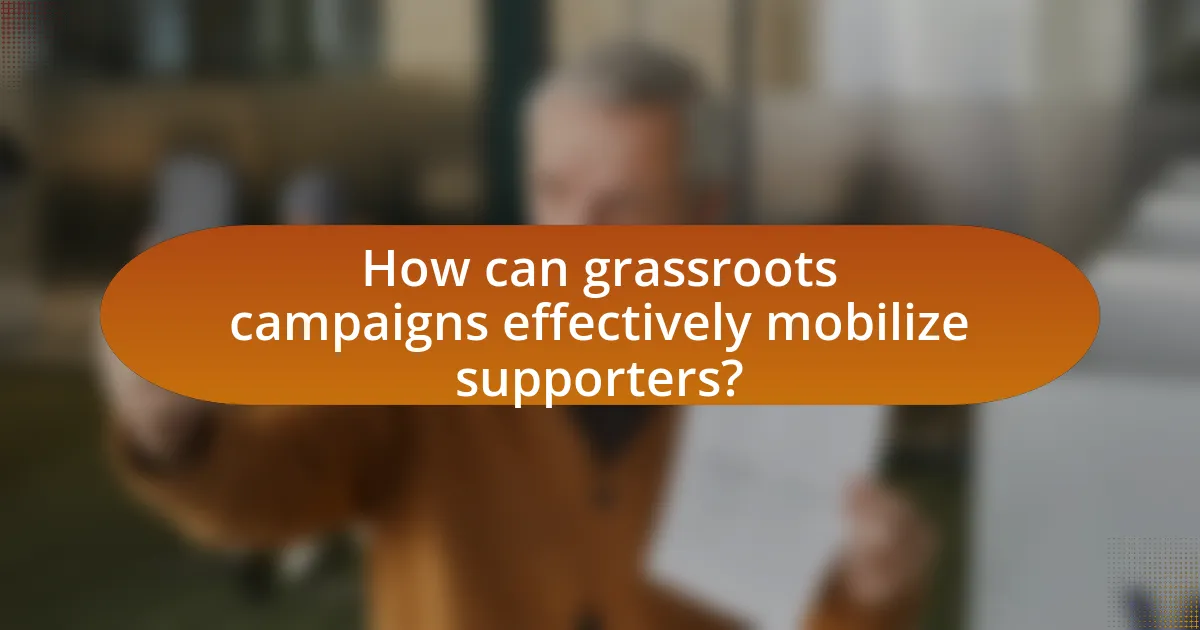
How can grassroots campaigns effectively mobilize supporters?
Grassroots campaigns can effectively mobilize supporters by leveraging community engagement and utilizing social media platforms. Engaging local communities through events, door-to-door outreach, and volunteer opportunities fosters personal connections and builds trust. For instance, a study by the Pew Research Center found that 69% of adults in the U.S. use social media, making it a powerful tool for grassroots campaigns to disseminate information and rally support quickly. Additionally, campaigns that focus on storytelling and shared values resonate more deeply with potential supporters, as evidenced by the success of movements like the Women’s March, which mobilized millions through relatable narratives and a strong sense of community.
What techniques can be used to engage the community?
Techniques to engage the community include organizing local events, utilizing social media platforms, and fostering partnerships with local organizations. Organizing local events, such as town hall meetings or community clean-ups, encourages participation and builds relationships among residents. Utilizing social media platforms allows for real-time communication and outreach, effectively reaching a broader audience. Fostering partnerships with local organizations can amplify efforts by pooling resources and expertise, as evidenced by successful campaigns that have leveraged community networks to increase engagement and participation rates.
How can social media be leveraged for grassroots mobilization?
Social media can be leveraged for grassroots mobilization by facilitating rapid communication, community building, and engagement among supporters. Platforms like Facebook, Twitter, and Instagram allow organizations to share information, organize events, and rally support efficiently. For instance, the Arab Spring demonstrated how social media enabled activists to coordinate protests and disseminate information quickly, leading to significant political change. Additionally, studies show that campaigns utilizing social media can increase participation rates; for example, a 2018 study published in the Journal of Communication found that social media engagement significantly boosted turnout in grassroots movements.
What role do local events play in building momentum?
Local events play a crucial role in building momentum for grassroots campaigns by fostering community engagement and creating a sense of urgency. These events provide a platform for individuals to connect, share ideas, and mobilize support around a common cause. For instance, studies have shown that community gatherings can increase participation rates by up to 50%, as they encourage face-to-face interactions and strengthen social ties. Additionally, local events often generate media coverage, amplifying the campaign’s message and attracting wider attention. This combination of personal connection and increased visibility effectively propels grassroots movements forward, making local events essential for sustained momentum.
How can messaging be tailored for maximum impact?
Messaging can be tailored for maximum impact by aligning it with the values and needs of the target audience. Effective messaging requires understanding the audience’s demographics, preferences, and motivations, which can be achieved through research and data analysis. For instance, a study by the Pew Research Center found that messages resonating with specific community values lead to higher engagement rates. Additionally, using clear, concise language and emotional appeals can enhance relatability and urgency, making the message more compelling. Tailoring messaging in this way not only increases the likelihood of audience engagement but also fosters a stronger connection to the campaign’s goals.
What are the best practices for creating compelling narratives?
The best practices for creating compelling narratives include understanding your audience, establishing a clear message, and using emotional appeal. Understanding your audience allows you to tailor the narrative to their values and beliefs, making it more relatable and impactful. Establishing a clear message ensures that the core idea is communicated effectively, which is crucial for grassroots campaigns aiming to mobilize support. Utilizing emotional appeal engages the audience on a personal level, fostering a connection that can drive action. Research indicates that narratives that evoke emotions can increase persuasion and retention of information, as demonstrated in studies by the University of Southern California, which found that emotionally charged stories are more likely to be shared and remembered.
How can campaigns ensure their messages resonate with diverse audiences?
Campaigns can ensure their messages resonate with diverse audiences by conducting thorough audience research to understand the unique values, beliefs, and preferences of different demographic groups. This approach allows campaigns to tailor their messaging and communication strategies effectively. For instance, a study by the Pew Research Center found that 72% of diverse audiences respond positively to messages that reflect their cultural backgrounds and experiences. By incorporating inclusive language, culturally relevant imagery, and addressing specific community issues, campaigns can enhance engagement and foster a sense of belonging among varied audience segments.
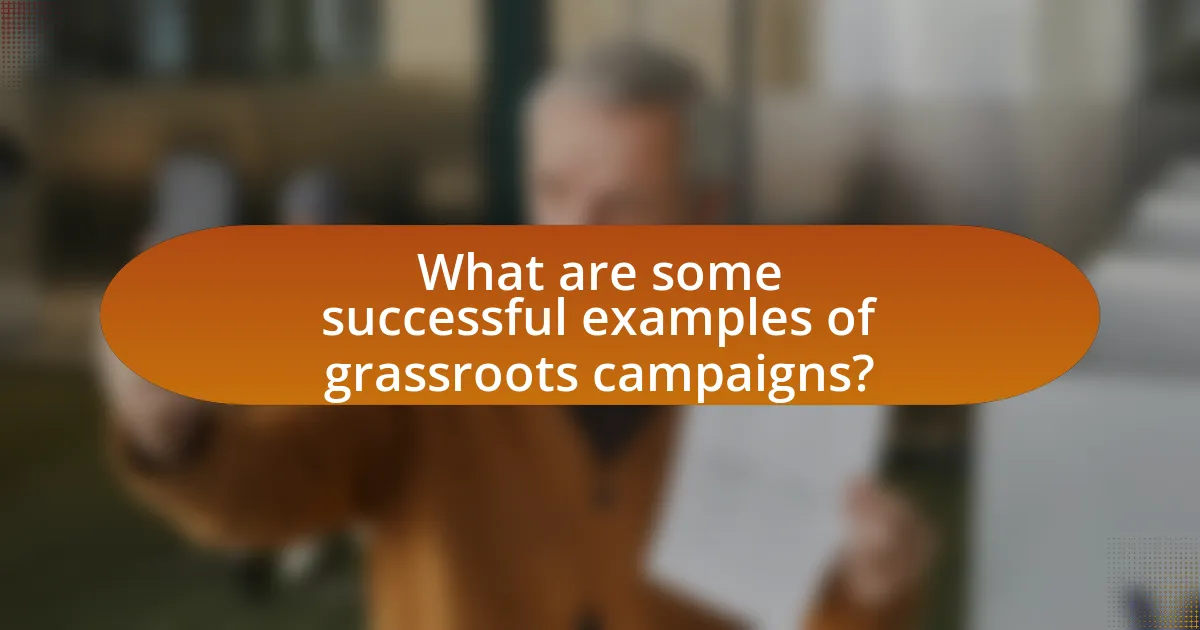
What are some successful examples of grassroots campaigns?
Successful examples of grassroots campaigns include the Civil Rights Movement, which effectively mobilized citizens to advocate for racial equality in the United States during the 1950s and 1960s, leading to significant legislative changes such as the Civil Rights Act of 1964. Another example is the Women’s March, which began in 2017 and united millions globally to advocate for women’s rights and social justice, demonstrating the power of collective action. Additionally, the Fight for $15 campaign has successfully raised awareness and pushed for a minimum wage increase across various states, resulting in policy changes in several cities and states. These campaigns illustrate the effectiveness of grassroots organizing in achieving social and political change.
What lessons can be learned from notable grassroots movements?
Notable grassroots movements teach the importance of community engagement and collective action in driving social change. For instance, the Civil Rights Movement in the United States demonstrated that organized, sustained efforts by ordinary citizens can lead to significant legislative changes, such as the Civil Rights Act of 1964. Additionally, the Women’s Suffrage Movement highlighted the effectiveness of strategic messaging and coalition-building, ultimately resulting in the 19th Amendment, which granted women the right to vote in 1920. These movements illustrate that grassroots efforts can mobilize public opinion, influence policymakers, and create lasting societal impact through persistent advocacy and community solidarity.
How did the campaign for climate action mobilize grassroots support?
The campaign for climate action mobilized grassroots support by leveraging community engagement and local activism to raise awareness about environmental issues. This approach involved organizing events, workshops, and rallies that encouraged individuals to participate actively in climate advocacy. For instance, the global climate strikes initiated by youth activists in 2019 saw millions of participants worldwide, demonstrating the power of grassroots mobilization. Additionally, social media platforms played a crucial role in disseminating information and connecting like-minded individuals, further amplifying the movement’s reach and impact.
What strategies were effective in the civil rights movement?
Effective strategies in the civil rights movement included nonviolent protests, legal challenges, and grassroots organizing. Nonviolent protests, exemplified by events like the Montgomery Bus Boycott and the March on Washington, mobilized public support and drew national attention to racial injustices. Legal challenges, such as Brown v. Board of Education, successfully dismantled segregation laws, establishing a legal precedent for equality. Grassroots organizing, through local chapters of organizations like the NAACP and SNCC, empowered communities to advocate for their rights and engage in voter registration drives, significantly increasing African American voter participation. These strategies collectively contributed to the advancement of civil rights and the eventual passage of landmark legislation like the Civil Rights Act of 1964 and the Voting Rights Act of 1965.
What innovative approaches are emerging in grassroots campaigning?
Innovative approaches emerging in grassroots campaigning include the use of digital tools for community engagement and data-driven strategies for targeting specific demographics. For instance, social media platforms enable grassroots organizations to mobilize supporters quickly and effectively, reaching wider audiences at a lower cost. Additionally, the integration of data analytics allows campaigns to tailor their messages based on voter behavior and preferences, enhancing the effectiveness of outreach efforts. Research from the Pew Research Center indicates that 69% of adults in the U.S. use social media, highlighting its potential as a powerful tool for grassroots mobilization.
How are technology and digital tools transforming grassroots efforts?
Technology and digital tools are transforming grassroots efforts by enhancing communication, mobilization, and fundraising capabilities. These tools enable grassroots organizations to reach wider audiences quickly through social media platforms, allowing for rapid dissemination of information and engagement with supporters. For instance, a study by the Pew Research Center found that 69% of adults in the U.S. use social media, which grassroots campaigns leverage to organize events and share messages effectively. Additionally, digital fundraising platforms like GoFundMe and Kickstarter have revolutionized how grassroots movements secure financial support, making it easier for individuals to contribute to causes they care about. This shift not only increases the visibility of grassroots initiatives but also fosters community building and collaboration among diverse groups.
What role does data analytics play in modern grassroots campaigns?
Data analytics plays a crucial role in modern grassroots campaigns by enabling targeted outreach and informed decision-making. Through the analysis of voter data, campaigners can identify key demographics, understand voter preferences, and tailor their messaging accordingly. For instance, a study by the Pew Research Center found that campaigns utilizing data analytics can increase voter engagement by up to 30%, as they can effectively reach and mobilize specific groups based on their interests and behaviors. This strategic use of data not only enhances resource allocation but also improves the overall effectiveness of grassroots efforts in driving social and political change.
What practical tips can enhance grassroots campaign effectiveness?
To enhance grassroots campaign effectiveness, focus on building strong community relationships and leveraging local networks. Engaging with community members fosters trust and encourages participation, which is crucial for mobilizing support. Research indicates that campaigns with strong local ties can increase volunteer engagement by up to 50%, as seen in the 2018 midterm elections where grassroots efforts significantly impacted voter turnout. Additionally, utilizing social media platforms for outreach allows campaigns to reach a broader audience quickly and efficiently, with studies showing that 70% of voters are influenced by social media interactions. Implementing these strategies can lead to more effective grassroots campaigns.
How can campaigns measure their impact and success?
Campaigns can measure their impact and success through various metrics such as engagement rates, conversion rates, and overall reach. Engagement rates can be assessed by analyzing social media interactions, email open rates, and participation in events, which indicate how well the campaign resonates with its audience. Conversion rates, which reflect the percentage of individuals taking a desired action, can be tracked through website analytics and lead generation forms. Additionally, overall reach can be quantified by monitoring the number of impressions and unique visitors across different platforms. These metrics provide concrete evidence of a campaign’s effectiveness and help in making data-driven adjustments for future initiatives.
What are the key takeaways for organizing a successful grassroots campaign?
Key takeaways for organizing a successful grassroots campaign include building a strong community network, clearly defining goals, and utilizing effective communication strategies. A strong community network fosters engagement and mobilizes supporters, as evidenced by the success of campaigns like the 2008 Obama campaign, which effectively utilized local volunteers. Clearly defined goals provide direction and measurable outcomes, allowing for focused efforts and resource allocation. Effective communication strategies, such as social media outreach and grassroots organizing, enhance visibility and encourage participation, as demonstrated by the rise of movements like Black Lives Matter, which leveraged social media to amplify their message and mobilize supporters.
